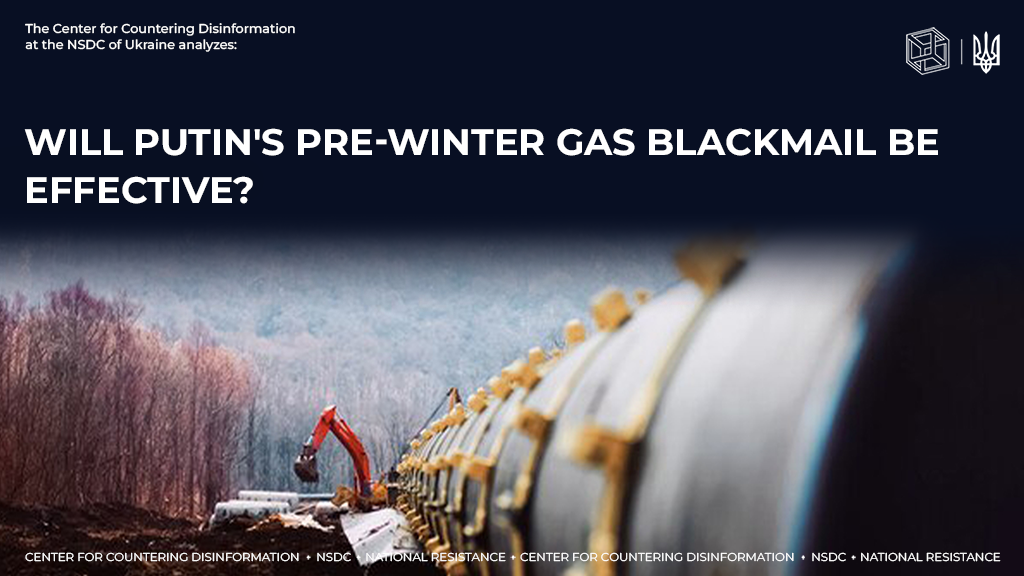Russia inflames Europeans’ fears about gas shortages in winter. It reduces gas supplies to prevent EU countries from preparing sufficient reserves for the winter. How does this threaten European countries? Will Ukraine have time to prepare for winter under these conditions?
Putin relies on soaring energy prices and possible shortages this winter to convince Europe to sway Ukraine to a truce on Russia’s terms and lift the ban on Nord Stream 2. How realistic are such hopes of Putin?
Before the war, the European Union was 40% dependent on blue fuel from Russia, consuming 155 billion cubic meters annually of Russian gas. Currently, on the pretext of maintenance of the gas-pumping unit of the pipeline “North Stream-1”, but in reality due to political motives, the Kremlin is “issuing” about 20% of the usual volume of gas to Europe. The geopolitical confrontation has raised gas prices to record levels. The spot price of gas in Europe in August exceeded the mark of $3,200 per thousand cubic meters.
However, the European Union revised its energy strategies and generally gave a confident response to Putin’s blackmail.
On the eve of the heating season, EU countries managed to fill up to 80% of their underground gas storages two months ahead of schedule, which is enough to provide gas to households, hospitals and critical infrastructure facilities. In addition, most EU countries have committed to reducing gas consumption by up to 15%, which seems to be quite a realistic goal.
Although Russia announced a complete suspension of gas supplies to France from September 1, the country’s dependence on Russian gas turned out to be somewhat exaggerated. Atomic energy plays a leading role in the energy balance of the country. Thus, according to the International Energy Agency, in 2020, of all the energy consumed in France, 42.3% came from nuclear energy, 28.3% from oil, 16.1% from gas, and 12.6% from renewable sources. According to experts, France already has sufficient gas reserves for the winter period and expects an increase of approximately 50% in the supply of Algerian gas.
In Germany, which is most dependent on Russian gas, against the backdrop of panic news, even the proposal of the Free Democratic Party to open Nord Stream 2 temporarily, to fill gas storage facilities for the winter were heard. The majority of German politicians did not support this proposal. In fact, the German authorities are successfully solving the issue of creating gas reserves for the winter due to emergency savings measures and increased imports from North-Western Europe (Norway and the Netherlands). Gas storages are filling up faster than planned; the goal of 85% filling set for October will be reached by the beginning of September.
The EU agreed on the ambitious Repower EU plan, which provides for the provision of 300 billion euros to replace Russian gas and includes the diversification of its supply.
In the future, as part of the Russian gas substitution program, the EU plans to increase to 35 billion cubic meters production of biomethane. As an alternative to Russian gas, Ukraine is able to offer the EU biomethane in the volume of up to 1 billion cubic meters in the coming years.
The blackmail of the Kremlin also accelerated the transition of the European Union to renewable energy sources – according to plans, their share will be 63% by 2030.
How can Ukraine withstand the increase in the price of Russian gas due to the impossibility of its reverse deliveries from the EU?
Ukraine’s annual consumption is 18.5-19 billion cubic meters of gas. Today, 12.2 billion cubic meters have been pumped into gas storage facilities by the end of the year, gas production by state mining enterprises will amount to about 3 billion cubic meters by private companies – about 3-4 billion. The situation is complicated by the fact that part of Ukrainian underground storage and gas production enterprises are located in occupied territories or where active hostilities continue, in particular in the Kharkiv region (about 50% of Ukrainian gas production volumes).
That is, the needs of Ukrainian household consumers in the heating season of 2022-2023. will be fully provided for.
Despite Putin’s attempts to use blue fuel as a weapon of political pressure and blackmail on Europe, it can be argued that none of the leading European countries will abandon the policy of supporting Ukraine in the war against Russia.
In the context of the European strategy of complete rejection of Russian gas, Ukraine should strengthen its integration into the European market and become an integral part of it.










